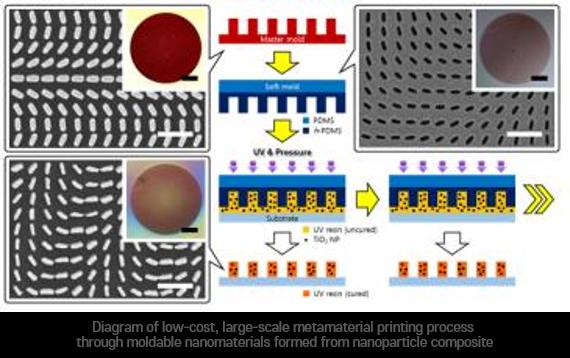
Credit: Junsuk Rho (POSTECH)
Zombies or enemies flashing right before your eyes and the dizzying feeling of standing on the edge of a cliff using virtual reality and augmented reality (AR and VR) are no longer exclusive to the games or media industries. Those technologies allow us to conduct virtual conferences, share presentations and videos, and communicate in real time in the virtual space. But because of the high cost and bulkiness of VR and AR devices, the virtual world is not within easy reach.
Recently, a South Korean research team developed moldable nanomaterials and a printing technology using metamaterials, allowing the commercialization of inexpensive and thin VR and AR devices.
Professor Junsuk Rho of the departments of mechanical engineering and chemical engineering and doctoral student in mechanical engineering Gwanho Yoon at POSTECH with Professor Heon Lee and researcher Kwan Kim of department of material science at Korea University have jointly developed a new nanomaterial and large-scale nanoprinting technology for commercialization of metamaterials. The research findings, which solve the issue of device size and high production costs that were problematic in previous researches, were recently published in Nature Communications, a prestigious scientific journal.
Metamaterials are substances made from artificial atoms that do not exist in nature but they freely control the properties of light. An invisible cloak that makes an illusion of disappearance by adjusting the refraction or diffraction of light, or metaholograms that can produce different hologram images depending on the direction of light’s entrance, uses this metamaterial.
Using this principle, the ultrathin metalens technology, which can replace the conventional optical system with extremely thinness, was recently selected as one of the top 10 emerging technologies to change the world in 2019 at the World Economic Forum.
In order to make metamaterials, artificial atoms smaller than the wavelengths of light must be meticulously constructed and arranged. Until now, metamaterials have been produced through a method called electron beam lithography (EBL)*.
However, EBL has hindered the commercialization or production of sizable metamaterials due to its slow process speed and high cost of production.
To overcome these limitations, the joint research team developed a new nanomaterial based on nanoparticle composite that can be molded freely while having optical characteristics suitable for fabricating metamaterials. The team also succeeded in developing a one-step printing technique that can shape the materials in a single-step process.
The team succeeded in producing an ultrathin metalens that is 100 times thinner than the strand of a human hair by using this newly developed technology. Metamaterials can be made into one-thousandth of thickness of heavy glass or plastic lenses. This is the first time in the world such ultrathin metalens was produced in a single-step printing process.
If the cost of making a metalens at the performance of conventional glass lenses were one million won (USD 8,200) per unit, this technology enables the production at about 10,000 won (USD 8), which is 1/100 the cost and 1/10,000 the thickness in a simplified process.
Professor Rho, who led the research, stated, “This one-step printing technology of nanomaterials allows the fabrication of metamaterials over 100 times faster than the conventional electron beam lithography.” He added, “These lenses can not only make the existing thick, large VR and AR lenses or glasses dramatically lighter and smaller, but can also be applied to curved or flexible panels, which facilitates the use of metamaterials in large omnidirectional invisible cloaks or in curved or bendable wearable devices at a fraction of the cost.”
###
The research was financially supported by the grants from the Mid-career Researcher Program, the Global Frontier Project (Wave Energy Control Research Group), the Regional Leading Research Center (RLRC), the Future Materials Discovery, and the Engineering Research Center (ERC) of the National Research Foundation (NRF) of the Ministry of Science and ICT (MSIT) of Korea.
Media Contact
Jinyoung Huh
[email protected]
Original Source
http://postech.
Related Journal Article
http://dx.




